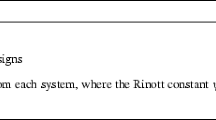Abstract
This paper presents a new method of constructing random functions whose realizations can be evaluated efficiently. The basic idea is to “blend,” both stochastically and linearly, a limited set of independent initial realizations previously generated by any chosen simulation method. The blending stochastic coefficients are determined in such a way that the new random function so generated has the same mean and covariance functions as the random function used for generating the initial realizations.
Similar content being viewed by others
REFERENCES
Deutsch, C. V., and Journel, A. G., 1998, GSLIB: Geostatistical Software Library and User's Guide, 2nd ed.: Oxford University Press, New York, 369 p.
Feller, W., 1966, An introduction to probability theory and its applications: v. 1: John Wiley, New York, 669 p.
Fourgeaux, C., and Fuchs, A., 1972, Statistique: Dunod, Monographies Universitaires de mathematiques, v. 24, Paris, 334 p.
Gomez, J., and Journel A. G., 1993, Joint sequential simulation of MultiGaussian Fields, in Soares, A., ed., Geostatistics Troia 92: Kluwer, Dordrecht, p. 493–506.
Goovaerts, P., 1997, Geostatistics for natural resources evaluation: Oxford Univ. Press, New York, 481 p.
Goovaerts, P., 1998, Accounting for estimation optimality criteria in simulated annealing: Math. Geology, v. 30, no. 5, p. 511–534.
Journel, A. G., 1989, Fundamentals of geostatistics in five lessons: Short course presented at the 28th International Geological Congress, Washington, DC, American Geophysical Union, 40 p.
Journel, A. G., and Huijbregts, CH. J., 1978, Mining geostatistics: Academic Press, New York, 600 p.
Matheron, G., 1973, The intrinsic random functions and their applications: Advances in Applied Probability, v. 5, p. 439–468.
Metivier, M., 1968, Notions fondamentales de la theorie des Probabilities: Dunod, Paris, 304 p.
Schwartz L., 1959, Théorie des distributions, 2nd ed.: Hermann, Paris, 418 p.
Srivastava, R. M., 1992, Reservoir characterization with probability field simulation, in Proceedings of the 67th SPE Conference, Washington, DC, paper no. 24753, Soc. of Pet. Eng., p. 927–938.
Tarantola, A., 1987, Inverse problem theory: Elsevier, Amsterdam, 613 p.
Tompson, A. F. B., Abadou, R., and Gelhar, L. W., 1989, Implementation of the three-dimensional turning bands random field generator: Water Resources Res., v. 25, no. 10, p. 2227–2243.
Verly, G., 1993, Sequential gaussian cosimulation: A simulation method integrating several types of information, in Soares A., ed., Geostatistics Troia '92: Kluwer Academic Publishers, Dordrecht, p. 543–554.
Author information
Authors and Affiliations
Rights and permissions
About this article
Cite this article
Mallet, J.L., Shtuka, A. Blending-Based Stochastic Simulator. Mathematical Geology 32, 367–379 (2000). https://doi.org/10.1023/A:1007590012189
Issue Date:
DOI: https://doi.org/10.1023/A:1007590012189




